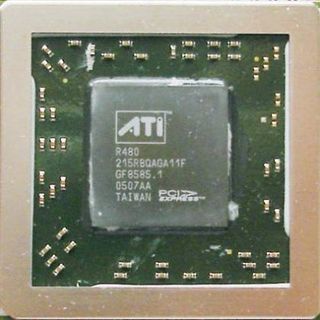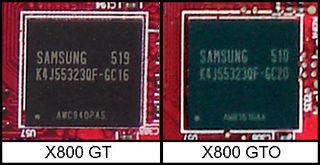Don't Throw Out Your ATI Radeon X800 Yet
X800 Flavors

This is the R430 core from the reference ATI Radeon X800 XL.
Both the ATI X800 GT and X800 GTO, as used in the graphics cards from Connect 3D and PowerColor, are composed of leftover R423, R430 or R480 GPU cores. "Leftover" means that the chips mostly did not yield the specification requirements and thus have been used for lower-end products. Many manufacturers take lower yielding parts and turn them into a product at a lower price point because the bean counters are looking to recoup every invested dollar as possible.
The X800 GT operates with eight pixel pipes, while the GTO has a total of 12. However, the basis always is at least a R430 graphics processor, as used in the X800 XL, which was manufactured at 110 nm for operation at 400/500 MHz clock speeds (core/memory). The R480 is actually the core that is used all the way up to the Radeon X850 XT Platinum Edition.
The retail ATI Radeon X800 XL sells for around $280, while the cards in this review are $175 or even less. Depending on the manufacturer and the stock cores they have in board production, you could end up with a gem at a discounted price, which is why we felt these products were worth a closer look.
While half of the chips' pipes are disabled with the X800 GT and 12 rather than 16 pipes are used with the X800 GTO, there is still a very good chance of getting rather nice overclocking results.

X800 GT actually uses the R480, the same as in the Radeon X850 XT PE, but this one did not meet the specifications needed to be placed into those high end cards.

Both X800 GT and GTO use GDDR3 memory from Samsung. While the GT's memory is rated at 1.6 ns for up to 600 MHz, the GTO's buffer are 2.0 ns parts for up to 500 MHz clock speed.
Stay on the Cutting Edge
Join the experts who read Tom's Hardware for the inside track on enthusiast PC tech news — and have for over 25 years. We'll send breaking news and in-depth reviews of CPUs, GPUs, AI, maker hardware and more straight to your inbox.
Most Popular

